Exploring Native
Native mobile app development refers to the process of creating applications specifically for a particular mobile operating system (OS) using platform-specific programming languages and development tools. The two most common platforms for native app development are iOS and Android. Native development, on the other hand, involves building separate versions of an application for each target platform using platform-specific programming languages and tools (Swift or Objective-C for iOS, Java or Kotlin for Android). In the realm of mobile app development software, the choice between native and cross-platform approaches is akin to selecting the right path for your enterprise’s digital journey. While this approach requires more resources and time, native apps offer superior performance, user experience, and access to platform-specific features.
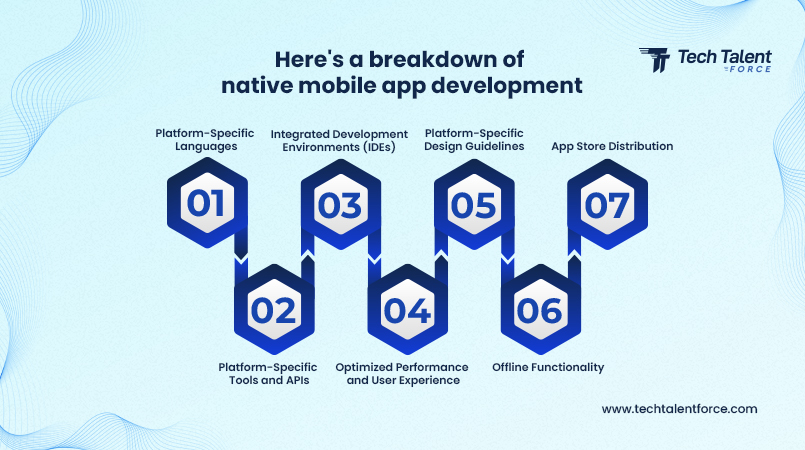
Here's a breakdown of native mobile app development
Platform-Specific Languages:
Native apps are developed using programming languages recommended by the respective platform. For iOS, developers primarily use Swift or Objective-C, while for Android, Java or Kotlin is commonly employed. These languages are optimized to work seamlessly with their respective platforms, ensuring better performance and integration.
Platform-Specific Tools and APIs:
Native app developers have access to a wide range of platform-specific tools, libraries, and APIs (Application Programming Interfaces). These tools allow developers to leverage the full capabilities of the device and OS, such as accessing the camera, GPS, push notifications, and other hardware features. By utilizing platform-specific APIs, developers can create highly optimized and feature-rich applications.
Integrated Development Environments (IDEs):
Native app development is typically done using dedicated IDEs tailored for each platform. For iOS development, XCode is the primary IDE, providing a comprehensive suite of tools for designing, coding, debugging, and testing iOS apps. Android Studio is the preferred IDE for Android development, offering similar functionalities tailored for the Android platform.
Optimized Performance and User Experience:
One of the key advantages of native app development is its ability to deliver optimal performance and user experience. As native apps are tailored for specific platforms, they can fully harness the capabilities of the device’s hardware and software. This results in smoother animations, faster response times, and overall better performance compared to cross-platform or hybrid apps.
Platform-Specific Design Guidelines:
Native app development adheres to platform-specific design guidelines and standards, such as Apple’s Human Interface Guidelines for iOS and Google’s Material Design for Android. By following these guidelines, developers ensure that their apps provide a consistent and intuitive user interface, enhancing user engagement and satisfaction.
Offline Functionality:
Native apps can often provide offline functionality by storing data locally on the device. This allows users to access certain features and content even when they’re not connected to the internet. Offline capabilities are particularly useful for apps that rely heavily on content consumption or data input.
App Store Distribution:
Native apps are distributed through official app stores such as the Apple App Store for iOS apps and Google Play Store for Android apps. App store distribution provides developers with access to a large user base and built-in distribution channels, making it easier to reach potential users and monetize their apps through in-app purchases or subscriptions.
Native mobile app development offers several advantages, including optimized performance, seamless integration with platform-specific features, and adherence to platform design standards. While native development may require separate codebases for each platform and specialized knowledge of platform-specific languages and tools, the benefits often outweigh the challenges, especially for apps that prioritize performance, user experience, and platform integration.
Advantages of Native Mobile Applications
Optimized Performance: Native apps offer superior performance and responsiveness due to their utilization of platform-specific code and APIs.
Improved User Experience: These apps offer a smooth and user-friendly interface, following platform-specific design principles and utilizing native user interface elements.
Access to Platform Features: Native development grants access to platform-specific features like GPS, camera, and push notifications, enabling developers to create feature-rich applications.
Disadvantages of Native Mobile Applications
Increased Development Expenses: Creating individual versions for each platform may incur higher costs as it requires specialized expertise and resources tailored to each platform.
Longer Development Time: Building native apps for multiple platforms requires more time compared to cross-platform development, potentially delaying time-to-market.
Exploring Cross-Platform Development
Cross-platform development is a methodology that allows developers to build mobile applications capable of running seamlessly on multiple operating systems, such as iOS and Android, using a single codebase. By leveraging these frameworks, developers can significantly reduce development time and costs, as they no longer need to create separate codebases for each platform. Instead, they can focus on building a unified codebase that can be easily adapted to different operating systems, streamlining the development process and accelerating time-to-market. Opting for the best cross-platform app development strategy can significantly reduce costs and accelerate time-to-market for enterprises aiming to reach a broad audience across multiple operating systems simultaneously.
Additionally, cross-platform development offers the advantage of broader reach, enabling apps to target a wider audience across different platforms simultaneously. This approach not only maximizes market penetration but also enhances user acquisition potential, ultimately driving business growth and success.
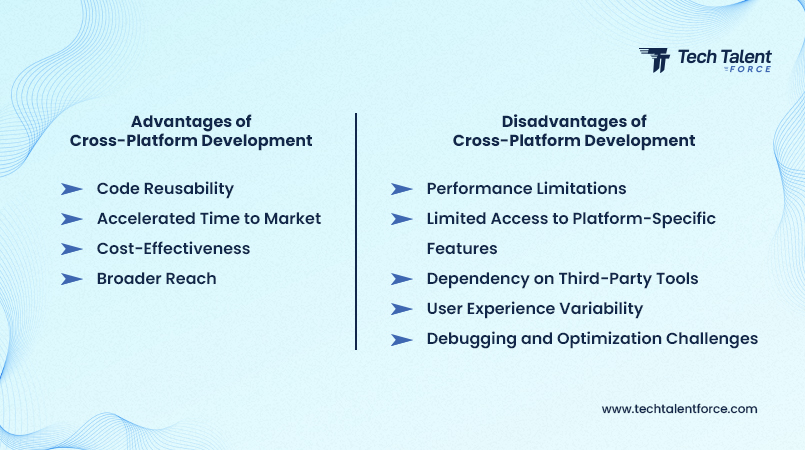
Advantages of Cross-Platform Development
Code Reusability: Cross-platform frameworks enable developers to write code once and deploy it across multiple platforms, reducing development time and effort.
Accelerated Time to Market: Cross-platform development expedites the app creation timeline by utilizing a unified codebase, enabling businesses to swiftly launch their apps and secure a competitive advantage in the market.
Cost-Effectiveness: By leveraging shared code and resources, cross-platform development can be more cost-effective than developing separate native apps for each platform, especially for startups and small businesses with limited budgets.
Broader Reach: Cross-platform apps can reach a wider audience by targeting multiple platforms simultaneously, maximizing market penetration and user acquisition potential.
Disadvantages of Cross-Platform Development
Performance Limitations: Cross-platform frameworks may not fully leverage the capabilities of each platform, resulting in slower performance compared to native apps.
Limited Access to Platform-Specific Features: Some advanced or niche features of iOS or Android may not be readily accessible or well-supported in cross-platform development environments.
Dependency on Third-Party Tools: Cross-platform development often relies on third-party tools and libraries, leading to potential compatibility issues, version conflicts, and reliance on external updates.
User Experience Variability: Ensuring consistent user experience across different platforms can be challenging, potentially leading to discrepancies in usability and interface design.
Debugging and Optimization Challenges: Debugging and optimizing code for multiple platforms simultaneously can be more complex and time-consuming compared to native development.
Factors to Consider When Choosing
Requirements: If your app demands high performance, responsiveness, and platform-specific optimizations, native development may be the preferred choice.
Budget and Time Constraints: Cross-platform development offers cost and time savings, making it a viable option for projects with limited resources and tight deadlines.
Target Audience and Market Demands: Consider the preferences and behavior of your target audience and the market dynamics of the platforms you intend to target.
Long-Term Maintenance and Scalability: Evaluate the long-term implications of your development approach in terms of maintenance, updates, and scalability requirements.
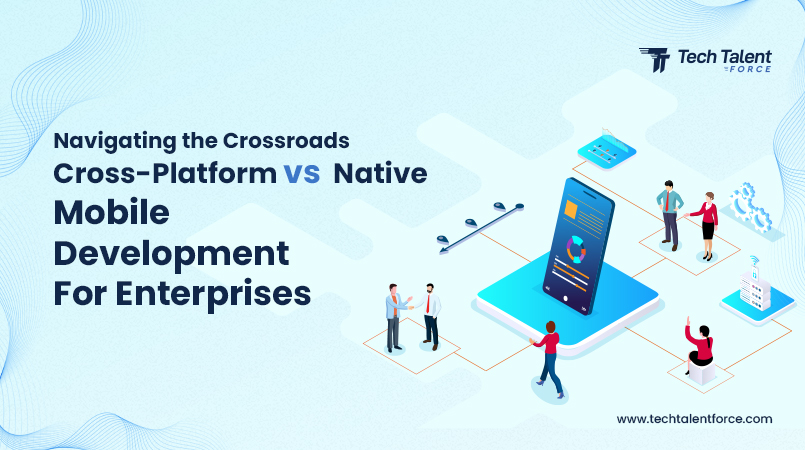
Navigating the Crossroads: Cross-Platform vs. Native Mobile Development for Enterprises.
Which option should they go for?
Mobile applications have become indispensable tools for enterprises looking to engage with their customers and streamline internal operations. When considering mobile app development, the choice between native vs. cross-platform hinges on factors like performance requirements, development timelines, and budget constraints, ultimately determining the optimal path for enterprises. However, one of the fundamental decisions that companies face when embarking on mobile app development is whether to opt for cross-platform or native development. Each approach comes with its own set of advantages and considerations, making the choice a crucial one for enterprises.
Factors to Consider
When deciding between cross-platform and native development, enterprises must weigh several factors to determine which option best aligns with their goals, resources, and requirements.
1. Performance and User Experience: Native apps are renowned for their exceptional performance and seamless user experience, as they leverage platform-specific APIs and optimizations. If your application requires high performance or demands extensive use of device capabilities, such as GPS, camera, or sensors, native development may be the preferable choice.
2. Time-to-Market: Cross-platform development offers faster development cycles and shorter time-to-market, thanks to code reusability and streamlined development processes. For enterprises looking to launch their app quickly and simultaneously across multiple platforms, cross-platform development can be advantageous.
3. Cost: Cost considerations play a significant role in the decision-making process. Cross-platform development typically requires less investment compared to native development, as it involves writing code once and deploying it across multiple platforms. However, native development may yield better long-term returns by delivering superior performance and user satisfaction.
4. Maintenance and Updates: Maintenance is an ongoing aspect of app development, requiring updates to address bugs, security vulnerabilities, and compatibility issues. Cross-platform apps may offer easier maintenance, as changes can be applied to a single codebase. Conversely, native apps require separate updates for each platform, potentially increasing maintenance efforts.
5. Target Audience and Market Share: Understanding your target audience and their preferences is crucial. If your audience predominantly uses a specific platform or expects a native experience, native development may be more appropriate. Conversely, cross-platform development allows you to reach a broader audience across different platforms with minimal effort.
Performance Considerations in Native and Cross-Platform Mobile App Development
When it comes to performance, both native and cross-platform mobile app development approaches have their own strengths and considerations. Native apps are renowned for their exceptional performance and seamless user experience, leveraging platform-specific APIs and optimizations. This results in smoother animations, faster response times, and overall better performance compared to cross-platform or hybrid apps.
On the other hand, cross-platform development offers benefits in terms of faster development cycles and shorter time-to-market. While there might be some performance limitations due to the abstraction layer provided by cross-platform frameworks, advancements in tools and technologies have significantly narrowed the performance gap between native and cross-platform apps. Modern cross-platform frameworks like React Native and Flutter have made significant strides in optimizing performance and bridging the performance divide.
Moreover, with the continuous improvement of cross-platform development tools and technologies, developers can now build high-performance apps that rival native ones in terms of speed and responsiveness. By utilizing native components and optimizing code for performance, cross-platform apps can deliver experiences that are on par with their native counterparts.
While native apps still hold an edge in terms of raw performance and platform-specific optimizations, cross-platform development has evolved to offer competitive performance levels, especially for applications that prioritize rapid development and deployment across multiple platforms. Ultimately, the choice between native and cross-platform development should consider various factors such as performance requirements, development timelines, budget constraints, and target audience preferences.
Making the Decision
Ultimately, the decision between cross-platform and native development depends on your enterprise’s unique needs, objectives, and constraints. Consider conducting a thorough analysis of the aforementioned factors, consulting with development experts, and evaluating the trade-offs between the two approaches.
For enterprises seeking a balance between cost-efficiency, time-to-market, and performance, cross-platform development may offer a compelling solution. However, if your application demands top-notch performance, platform-specific features, and unparalleled user experience, native development might be the optimal choice despite its higher upfront investment.
In summary, the decision between cross-platform and native mobile development holds immense significance for your enterprise’s mobile strategy. By thoroughly assessing the factors and aligning them with your business goals, you can make a well-informed choice that fosters innovation, boosts user engagement, and adds value to your customers. Both native and cross-platform approaches come with their own merits and drawbacks, and the optimal selection hinges on considerations like performance needs, financial constraints, target audience, and long-term objectives. By carefully evaluating these factors and grasping the distinct traits of each approach, businesses can confidently embark on successful mobile app development endeavours. Whether you prioritize the top-tier performance of native apps or the flexibility and cost-effectiveness of cross-platform solutions, the ultimate goal remains consistent: delivering exceptional user experiences that captivate and benefit your users.
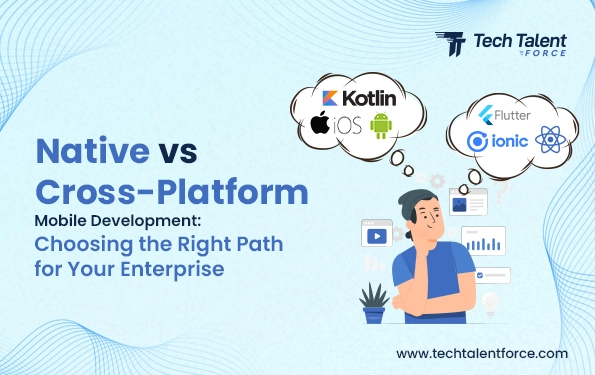



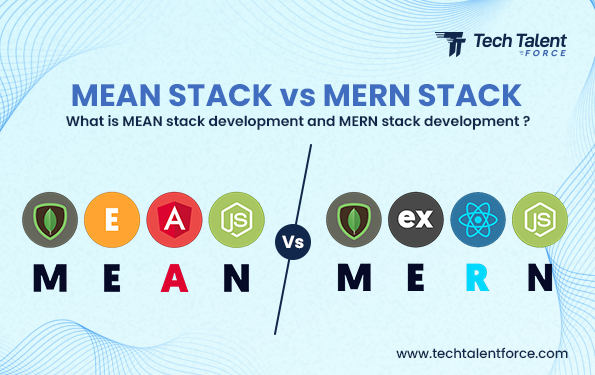
No Comments